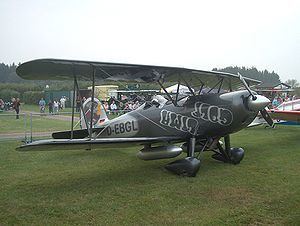Top speed 213 km/h Length 6.2 m First flight 1929 | Wingspan 8.13 m Engine type Lycoming O-360 | |
 | ||
Unit cost 245,000–245,000 USD (2013) Manufacturers WACO Classic Aircraft, Great Lakes Aircraft Company | ||
Great lakes sport trainer
The Great Lakes Sport Trainer is an American biplane trainer and aerobatic aircraft. Originally produced in large numbers before the company building it went bankrupt in the Great Depression in 1933. Owing to its continuing popularity, however, it was eventually placed back into production in the 1970s and again in 2011 by WACO Classic Aircraft.
Contents
- Great lakes sport trainer
- Development and design
- Operational history
- Variants
- Specifications Model 2T 1A 2
- References
Development and design
The Great Lakes Aircraft Corporation of Cleveland, Ohio produced a design for a small two-seat sports/trainer in early 1929, with the first prototype flying in March 1929. The resulting aircraft, designated 2-T-1 was a single bay biplane of mixed, fabric-covered construction and with a tailskid undercarriage. Power was by a single 85 hp (63 kW) Cirrus III inline engine (as the Detroit Aircraft Corporation, the holding company for Great Lakes, also held the American rights to the Cirrus, so all Sports Trainers were originally sold with Cirrus engines). Initial testing showed that the aircraft was tail heavy, so after the first four aircraft were built, the upper wing was swept back.
In January 2011, WACO Classic Aircraft announced that it will put the Great Lakes Model 2T-1A-1/2 model biplane back into production. The aircraft had not been available since 1980. The aircraft will incorporate several changes including metal wing spars. It will be offered in two models, a touring model, with a Lycoming IO-360-B1F6 engine and a higher-performance sport model, with a Lycoming AEIO-360-B1G6 engine. Work on the new production model was completed in June 2013 and the base price announced as US$245,000.
Operational history
The aircraft proved very successful, with about 250 built before construction ended. It was highly maneuverable even on the relatively modest power of a Cirrus engine, one aircraft holding for many years the world record for consecutive outside loops, a total of 131, set by Jim Moss flying the Hunt Special.
The Great Lakes continued to be popular well after production ended, many aircraft being re-engined with more powerful engines, particularly Jacobs radial engines. Eventually, in the 1960s, the rights for the Sport Trainer were acquired by Harvey Swack, who offered plans of the aircraft for sale to homebuilders. In 1972, Swack sold the rights on to Doug Champlin, who set up a reconstituted Great Lakes Aircraft Company to produce a revised version meeting the current airworthiness requirements, powered by modern Lycoming engines and revised materials of construction (including the use of Douglas Fir instead of Spruce). The first of the new production aircraft, the Model 2T-1A-1, powered by a 140 hp engine was certified in May 1973, with production starting in October that year. A more powerful version, the 2T-1A-2 followed in July 1974. In 1978 production was divided between Witchita Kansas and Enid, Oklahoma with the intent on relocation to Florida.
Rights to the Sport Trainer continued to switch hands, resulting in production moving several times. By 1980, 137 Sport Trainers had been built. Production finally finished in 1985.
Variants
Specifications (Model 2T-1A-2)
Data from Jane's All The World's Aircraft 1976-77
General characteristics
Performance
